牛津小学六年级英语6A教材培训完美版
- 格式:ppt
- 大小:267.00 KB
- 文档页数:47
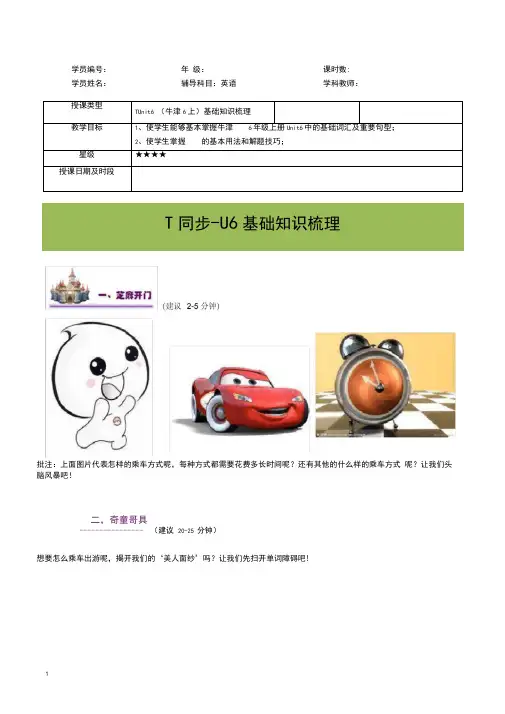
学员编号:年级:课时数:学员姓名:辅导科目:英语学科教师:授课类型TUnit6 (牛津6上)基础知识梳理教学目标1、使学生能够基本掌握牛津6年级上册Unit6中的基础词汇及重要句型;2、使学生掌握的基本用法和解题技巧;星级★★★★授课日期及时段T同步-U6基础知识梳理批注:上面图片代表怎样的乘车方式呢,每种方式都需要花费多长时间呢?还有其他的什么样的乘车方式呢?让我们头脑风暴吧!二,奇童哥具---------------- (建议20-25 分钟)想要怎么乘车出游呢,揭开我们的‘美人面纱’吗?让我们先扫开单词障碍吧!Ready, go!! |1. travel v. / n. 行走,旅行e. g. The girl is traveling in the Europe. 那个女孩欧洲旅行。
I want another travel to Beijing . 我想再次出游北京。
批注:先让学生回顾都有哪些表示旅行的词语,然后在对这些词语进行详细的区别【知识拓展】traveler n.游者,游客 go travelling 去旅游2 2. ferry n. (1)渡船 (2)渡口 v.(用船或飞机等)运送(货物)(通常指短程的或定期的)e.g. I like to go to work by ferry.我喜欢乘船上班。
批注:先让学生回顾各种交通方式,进而引导出各种交通方式的表达方法【知识拓展】by ferry 乘船 中 3. advertisement n.广告e. g. There are many advertisements around us .我们周围有很多的广告。
5. few a.几乎没有,修饰可数名词复数 【知识拓展】a few 一些,用于修饰可数名词复数e.g. There few apples in the basket .篮子里几乎没有苹果。
批注:由few 引导出a few ,然后对其进行区别,最后再跟容易混在一起考试的 进行记忆 、重要句型 Important Sentences structures1. He goes to school by bus. 他乘公共汽车去上学。
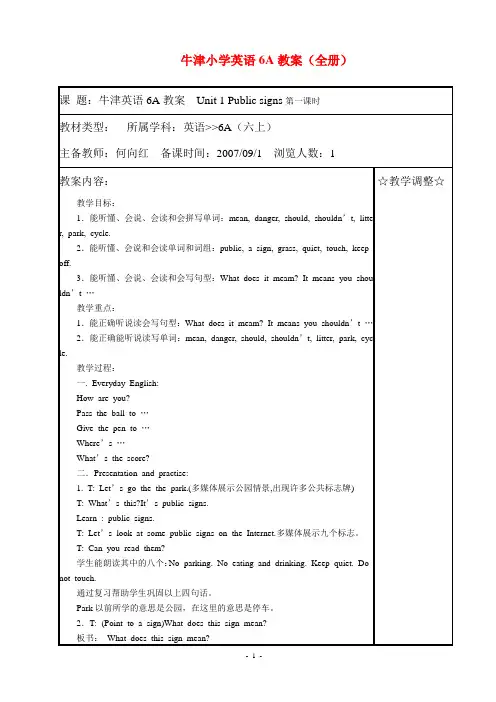
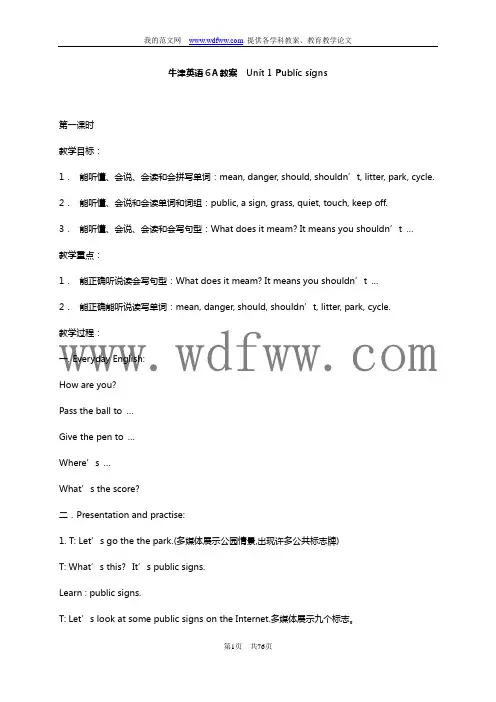
牛津英语6A教案Unit 1 Public signs第一课时教学目标:1.能听懂、会说、会读和会拼写单词:mean, danger, should, shouldn’t, litter, park, cycle. 2.能听懂、会说和会读单词和词组:public, a sign, grass, quiet, touch, keep off.3.能听懂、会说、会读和会写句型:What does it meam? It means you shouldn’t …教学重点:1.能正确听说读会写句型:What does it meam? It means you shouldn’t …2.能正确能听说读写单词:mean, danger, should, shouldn’t, litter, park, cycle.教学过程:一. Everyday English:How are you?Pass the ball to …Give the pen to …Where’s …What’s the score?二.Presentation and practise:1. T: Let’s go the the park.(多媒体展示公园情景,出现许多公共标志牌)T: What’s this? It’s public signs.Learn : public signs.T: Let’s look at some public signs on the Internet.多媒体展示九个标志。
T: Can you read them?学生能朗读其中的八个:No parking. No eating and drinking. Keep quiet. Do not touch.通过复习帮助学生巩固以上四句话。
Park以前所学的意思是公园,在这里的意思是停车。
2.T: (Point to a sign)What does this sign mean?板书: What does this sign mean?学习这句话,讲解mean的意思及其中ea的发音。
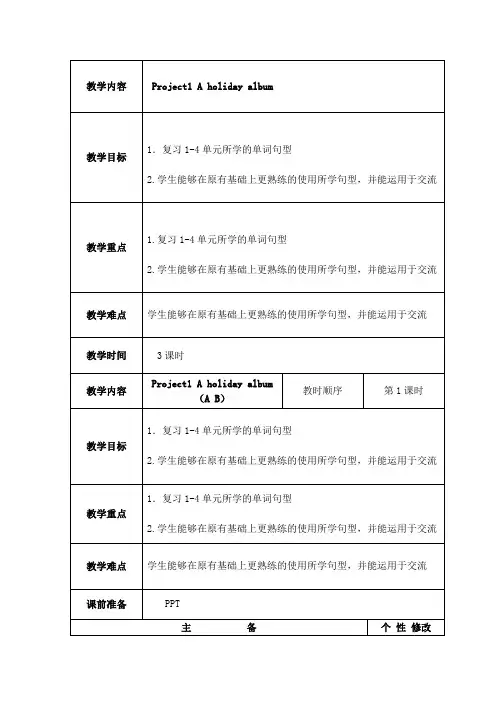
教学内容Project1 A holiday album教学目标1.复习1-4单元所学的单词句型2.学生能够在原有基础上更熟练的使用所学句型,并能运用于交流教学重点1.复习1-4单元所学的单词句型2.学生能够在原有基础上更熟练的使用所学句型,并能运用于交流教学难点学生能够在原有基础上更熟练的使用所学句型,并能运用于交流教学时间3课时教学内容Project1 A holiday album(A B)教时顺序第1课时教学目标1.复习1-4单元所学的单词句型2.学生能够在原有基础上更熟练的使用所学句型,并能运用于交流教学重点1.复习1-4单元所学的单词句型2.学生能够在原有基础上更熟练的使用所学句型,并能运用于交流教学难点学生能够在原有基础上更熟练的使用所学句型,并能运用于交流课前准备PPT主备个性修改Step1.Warm up1.Greetings.2.Free talkWhat day is it today?What day was it yesterday?How is the weather today?How was the weather yesterday?Where did you go this summer holiday?What did you do last weekends?Step2.Presentaiton1.Review the words:Bund/Great Wall/Palace Museum/Shanghai Museum/Summer Palace/Tian’anmen Square(出示单词卡片,帮助学生回忆所学单词)2.Show my holiday album(教师先出示自己的假期相册,先向同学们说明自己所去的地方,并且对自己所去的地点进行简单地介绍,为后面学生介绍做好铺垫,让学生能够模仿着去说。
)3.draw and say(part A)Everyone should draw a place you have gone in your life. And try to introduce the place to your classmate.(每个同学都要简单地画出自己曾经去过的一个地方,并且用简单的语句向你的同学们介绍这个地方。
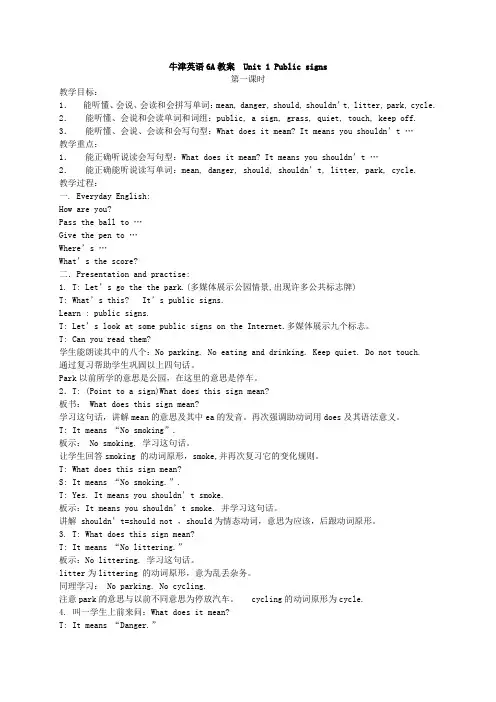
牛津英语6A教案Unit 1 Public signs第一课时教学目标:1.能听懂、会说、会读和会拼写单词:mean, danger, should, shouldn’t, litter, park, cycle. 2.能听懂、会说和会读单词和词组:public, a sign, grass, quiet, touch, keep off. 3.能听懂、会说、会读和会写句型:What does it meam? It means you shouldn’t …教学重点:1.能正确听说读会写句型:What does it meam? It means you shouldn’t …2.能正确能听说读写单词:mean, danger, should, shouldn’t, litter, park, cycle.教学过程:一. Everyday English:How are you?Pass the ball to …Give the pen to …Where’s …What’s the score?二.Presentation and practise:1. T: Let’s go the the park.(多媒体展示公园情景,出现许多公共标志牌)T: What’s this? It’s public signs.Learn : public signs.T: Let’s look at some public signs on the Internet.多媒体展示九个标志。
T: Can you read them?学生能朗读其中的八个:No parking. No eating and drinking. Keep quiet. Do not touch.通过复习帮助学生巩固以上四句话。
Park以前所学的意思是公园,在这里的意思是停车。
2.T: (Point to a sign)What does this sign mean?板书: What does this sign mean?学习这句话,讲解mean的意思及其中ea的发音。
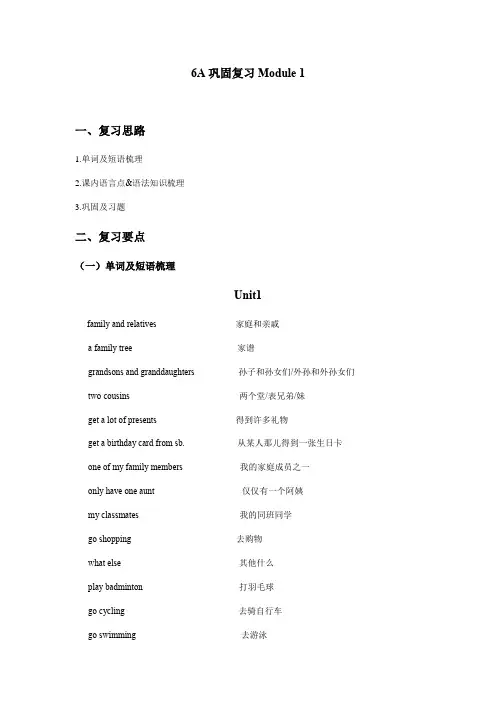
6A巩固复习Module 1一、复习思路1.单词及短语梳理2.课内语言点&语法知识梳理3.巩固及习题二、复习要点(一)单词及短语梳理Unit1family and relatives 家庭和亲戚a family tree 家谱grandsons and granddaughters 孙子和孙女们/外孙和外孙女们two cousins 两个堂/表兄弟/妹get a lot of presents 得到许多礼物get a birthday card from sb. 从某人那儿得到一张生日卡one of my family members 我的家庭成员之一only have one aunt 仅仅有一个阿姨my classmates 我的同班同学go shopping 去购物what else 其他什么play badminton 打羽毛球go cycling 去骑自行车go swimming 去游泳how many + 名词复数多少……Unit2Ⅰ. 词性转换1.friend n. 朋友→friendly adj. 友好的→* friendship n.友谊2.help n./v.帮助→helpful adj.有帮助的→* helpless adj.无帮助的3.one的序数词→first4.pollute v. 污染→pollution n.污染5.discuss v. 讨论→*discussion n. 讨论e n.用法,用处v.使用→useful adj.有用→* reuse v. 再利用1.talk to/with her和她交谈2.not…at all一点也不……3.like to play together喜欢一起玩4.almost every day几乎每一天5.can’t read or write不能读和写6.go out at night在晚上出去7. a little dog一条小狗8.like to be together喜欢在一起9.walk to school= go to school on foot步行去学校10.eat their lunch吃午饭11.share their food分享食品12.help each other互相帮助13.help other people帮助他人14.friendly and helpful友善待人,助人为乐15.work hard勤奋学习16.be (never) late for school上学(从不)迟到17.(never) get angry(从不)生气。
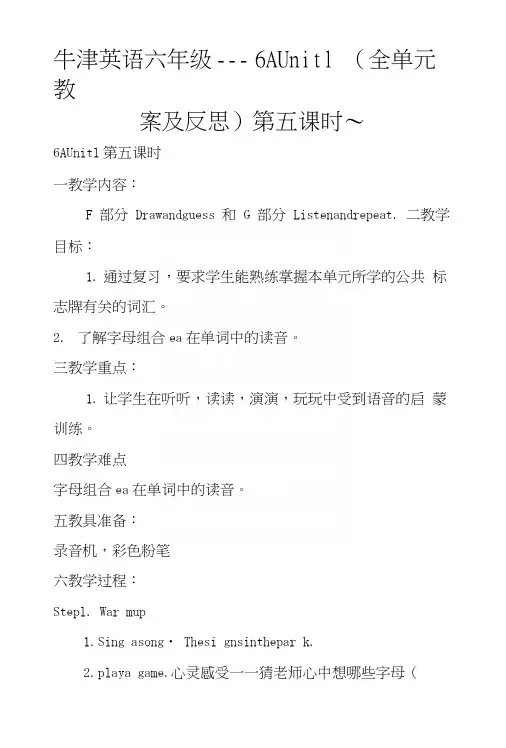
牛津英语六年级--- 6AUnitl (全单元教案及反思)第五课时〜6AUnitl第五课时一教学内容:F 部分Drawandguess 和G 部分Listenandrepeat. 二教学目标:1.通过复习,要求学生能熟练掌握本单元所学的公共标志牌有关的词汇。
2.了解字母组合ea在单词中的读音。
三教学重点:1.让学生在听听,读读,演演,玩玩中受到语音的启蒙训练。
四教学难点字母组合ea在单词中的读音。
五教具准备:录音机,彩色粉笔六教学过程:Stepl. War mup1.S ing asong・ Thesi gnsinthepar k.2.p laya game.心灵感受一一猜老师心中想哪些字母(a. e. m. n ) 以So rry, yoursqu o;rewrong・ T ryagainYes, yoursquojre right评价,为F部分游戏做铺垫。
把这四个合成一个词(mean)・用mean说一句话。
指导:Whatdo esitmean? (m ean 用原形)It meansDanger ? (mean 力口s)Step2. Prese ntation (学习G 部分)1•看图呈现单词①T: Boyand girls, canyo useealittle boyinthepic ture?Whatis hewearing?板书sweater.指导学生朗读该单词,注意纠正ea组合发音的口形。
②T:Whatis theboydoing ?板书head,并指导朗读该单词。
(3)T:Whyistheboy shakinghish ead?板书bre adbreakfast ,并指导朗读。
④读一读,体会一下swea ter, head,br ead, breakfa st 这四个词中ea组合的发音规律。
2•总结发音规律,举例加以拓展。
①发音headache , ready.②发音s ea, eat, mean3.趣读句子①录音范读,呈现句子。
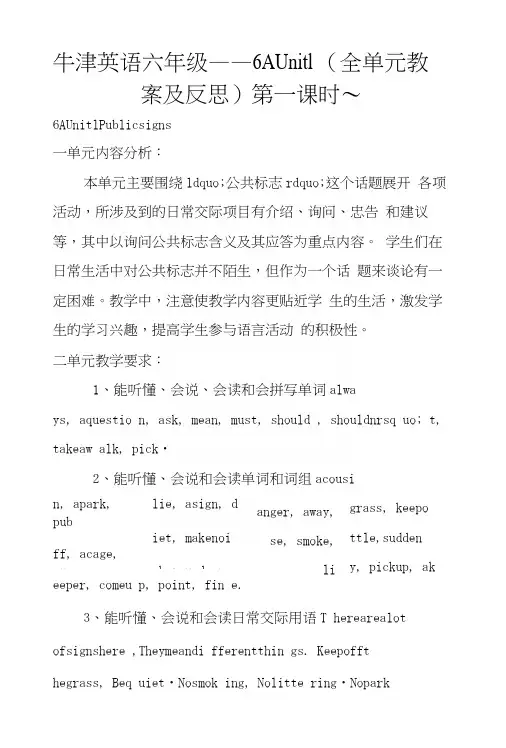
牛津英语六年级——6AUnitl (全单元教案及反思)第一课时〜6AUnitlPublicsigns一单元内容分析:本单元主要围绕ldquo;公共标志rdquo;这个话题展开 各项活动,所涉及到的日常交际项目有介绍、询问、忠告 和建议等,其中以询问公共标志含义及其应答为重点内容。
学生们在日常生活中对公共标志并不陌生,但作为一个话 题来谈论有一定困难。
教学中,注意使教学内容更贴近学 生的生活,激发学生的学习兴趣,提高学生参与语言活动 的积极性。
二单元教学要求:1、能听懂、会说、会读和会拼写单词always, aquestio n, ask, mean, must, should , shouldnrsq uo; t, takeaw alk, pick ・2、能听懂、会说和会读单词和词组acousieeper, comeu p, point, fin e. 3、能听懂、会说和会读日常交际用语T herearealotofsignshere ,Theymeandi fferentthin gs. Keepoffthegrass, Beq uiet ・Nosmok ing, Nolitte ring ・Noparkn, apark,pub ff, acage,qu lie, asign, diet, makenoiokaround, ne anger, away, se, smoke, li grass, keepo ttle,sudden y, pickup, aking. Noeat in gordrinking ・ Danger! Don ottouch ・4、能听懂、会说、会读和会写句型Whatdoe sit/this/th atmean?Itme ansyou/wemu st/should/s houldnrsquo ; thellip;5、了解字母组合ea在单词中的读音。
6、会唱歌曲Thesignsi nthepark.三单元教学重难点:1、能听懂、会说、会读和会拼写单词always, aquestion,a sk, mean, mus t, should,sh ouldnrsquo; t, takeawalk , pick.2、能听懂、会说、会读和会写句型What does it/this/that mean?Itmean syou/wemust /should/sho uldnrsquo; t hellip;四单元教具准备:1、图字卡。
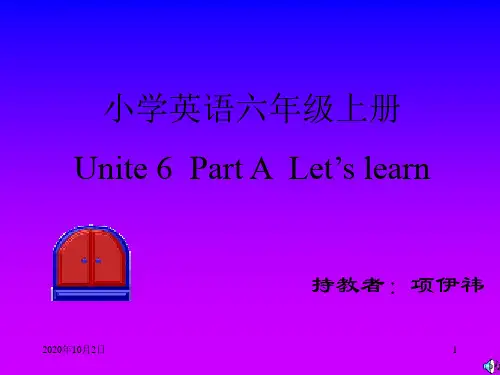
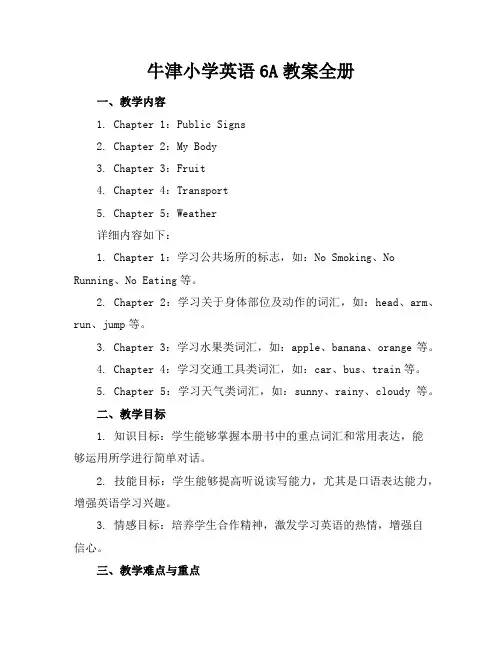
牛津小学英语6A教案全册一、教学内容1. Chapter 1:Public Signs2. Chapter 2:My Body3. Chapter 3:Fruit4. Chapter 4:Transport5. Chapter 5:Weather详细内容如下:1. Chapter 1:学习公共场所的标志,如:No Smoking、No Running、No Eating等。
2. Chapter 2:学习关于身体部位及动作的词汇,如:head、arm、run、jump等。
3. Chapter 3:学习水果类词汇,如:apple、banana、orange等。
4. Chapter 4:学习交通工具类词汇,如:car、bus、train等。
5. Chapter 5:学习天气类词汇,如:sunny、rainy、cloudy等。
二、教学目标1. 知识目标:学生能够掌握本册书中的重点词汇和常用表达,能够运用所学进行简单对话。
2. 技能目标:学生能够提高听说读写能力,尤其是口语表达能力,增强英语学习兴趣。
3. 情感目标:培养学生合作精神,激发学习英语的热情,增强自信心。
三、教学难点与重点1. 教学难点:词汇的读音和用法,日常对话的表达。
2. 教学重点:重点词汇和句型的掌握,口语表达能力的提高。
四、教具与学具准备1. 教具:教材、录音机、磁带、卡片、挂图等。
2. 学具:练习本、笔、卡片等。
五、教学过程1. 导入:通过创设实践情景,引入新课。
例如,在讲解Chapter 1时,展示公共场所的图片,引导学生说出相关标志。
2. 新课呈现:呈现新课内容,引导学生学习词汇和句型。
3. 例题讲解:针对重点内容,进行讲解和示范。
4. 随堂练习:进行小组讨论、角色扮演等实践活动,巩固所学。
六、板书设计Chapter 1:Public Signs:No Smoking、No Running、No Eating句型:This is a It meansChapter 2:Body Parts:head、arm、legActions:run、jump、danceChapter 3:Fruit:apple、banana、orangeChapter 4:Transport:car、bus、trainChapter 5:Weather:sunny、rainy、cloudy七、作业设计1. 作业题目:(1)抄写本章重点词汇和句型,每个词汇写5遍。
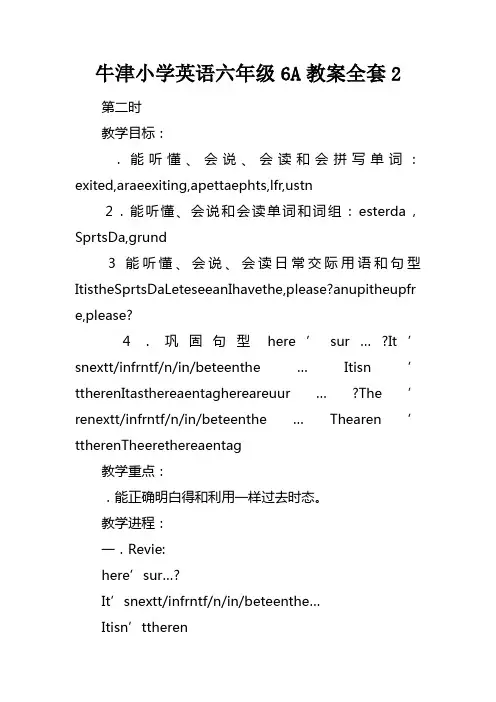
牛津小学英语六年级6A教案全套2第二时教学目标:.能听懂、会说、会读和会拼写单词:exited,araeexiting,apettaephts,lfr,ustn2.能听懂、会说和会读单词和词组:esterda,SprtsDa,grund3能听懂、会说、会读日常交际用语和句型ItistheSprtsDaLeteseeanIhavethe,please?anupitheupfr e,please?4.巩固句型here’sur…?It’snextt/infrntf/n/in/beteenthe…Itisn’ttherenItasthereaentaghereareuur…?The’renextt/infrntf/n/in/beteenthe…Thearen’ttherenTheerethereaentag教学重点:.能正确明白得和利用一样过去时态。
教学进程:一.Revie:here’sur…?It’snextt/infrntf/n/in/beteenthe…Itisn’ttherenItasthereaentaghereareuur…?The’renextt/infrntf/n/in/beteenthe…Thearen’ttheren Theerethereaentag出示图片让学生进行问答。
二.Presentatinandpratise:出示文挂图。
T:hataretheding?S:The’rerunningT:es,thearehavingarunningraeLearn:raeT:ThestudentsareverexitedLearn:exitedT:hatareSuHaiandSuangding?Let’slistentthetape听文第一段录音。
学生回答下列问题。
S:SuHaiislingfrheraeraSuangishelpingher 讲解:lfr意思为寻觅。
将之区别find2听文第二段录音回答下列问题。
牛津小学6A英语教材全解Unit 5 On the farm主备:张钰教学目标:1.听懂、会说、会读和会拼写单词及短语plant, milk, a cow, else, taste, pull up 及其中动词的过去式。
2.能听懂、会说、会读日常交际用语和句型Did you like the film? It was a funny cartoon. We all liked it very much. Were there any fruit trees on the farm? There were apple trees, orange trees and pear trees. Whatdid you do … ? I …3.能听懂、会说、会读单词 a holiday, last, a farm, a carrot, fun, collect, a camp.Free talk:When’s your birthday?What date is it today?What day is it today?一.Presentation and practise:1. T: Do you know something about the farm.. Now let’s go to the farm.出示词汇部分图片。
T: What he/she doing? Do you know?S: He/she is …其中八个词语中 cook, collect, milk, pick,water是已学过的词语,稍微复习一下学生遍掌握了。
让学生了解milk以前的意思为牛奶,在这里指挤奶,并拼读这个四会单词。
plant, taste, pull up 为新内容,让学生边读边做动作并反复拼读。
2.多媒体播放国庆节的场景T: Boys and girls, do you know the National Day.Learn: National DayT: I watched a film on the National Day.板书,并让学生观察动词有什么变化。
牛津小学英语6A教案全册一、教学内容1. Unit 1 Public signs学习公共场所的标志及其意义。
掌握相关词汇:sign, public, understand, no, smoking, parking, crossing, caution, danger, keep off。
学习一般现在时的用法。
2. Unit 2 National flags认识不同国家的国旗,了解其设计元素和象征意义。
掌握相关词汇:flag, national, country, design, symbol, represent, red, white, blue, star, union jack。
巩固一般现在时的用法。
二、教学目标1. 让学生掌握公共场所标志的英文表达,提高学生的社会常识。
2. 使学生了解各国国旗的特点,拓宽学生的国际视野。
3. 培养学生运用一般现在时描述标志和国旗的能力。
三、教学难点与重点1. 教学难点:公共场所标志的英文表达、国旗设计元素和象征意义的理解。
2. 教学重点:一般现在时的运用,以及相关词汇的掌握。
四、教具与学具准备1. 教具:PPT、公共场所标志卡片、各国国旗图片。
2. 学具:学生用书、练习册、单词卡片。
五、教学过程1. 导入:展示公共场所标志的图片,引导学生用英文表达所见所闻,激发学生兴趣。
2. 新课内容展示:通过PPT展示公共场所标志和各国国旗,引导学生学习相关词汇和一般现在时的用法。
3. 例题讲解:结合教材中的例题,讲解公共场所标志和各国国旗的表达方式,并进行拓展。
4. 随堂练习:学生根据所学内容,完成教材中的练习题,巩固所学知识。
5. 小组讨论:学生分组讨论公共场所标志的作用和各国国旗的特点,提高合作能力。
六、板书设计1. Unit 1 Public signs & Unit 2 National flags2. 主要内容:Unit 1:sign, public, understand, no, smoking, parking, crossing, caution, danger, keep offUnit 2:flag, national, country, design, symbol, represent, red, white, blue, star, union jack3. 重点语法:一般现在时七、作业设计1. 作业题目:(1)根据所学内容,绘制一幅公共场所标志的画,并用英文标注。
3.How often does your mother go to the s_________? school4.Shall I wait for you at the underground s_______ at three o’clock ? station5.There is a beautiful fountain in our h_______ e________. housing estate6.I visited a lot of t_______ when I was in Thailand(泰国). templesIII.Read, choose and complete1.I often see an old lady selling flowers ______(to/on) my way to school. on2.It takes John ______(only/almost)3 minutes to go to work on foot. only3._____ _____ (How far/How long) does it take your mother to cook food every day? How long4._____ _____ (How many/How much) time do you spend on your lessons, Susie? How much5.I saw some hawkers _______ (when/after) I was on the bus to school yesterday. when6.There’s a supermarket near my flat. I always go there ___ (on/by) foot. onIV.Read and choose( C ) 1. My cousin goes to school ______light rail every day.A) on B) on a C) by D) by a( D ) 2. When I am on the school bus, I can see many ______.A) temple B) kindergarten C) hotel D) people( A ) 3. Do you ______ the new post office when you walk to your factory ?A) see B) look at C) look D) to see( B ) 4. My father likes to read newspaper when he is ______ the undergrand.A) at B) on C) by D) in( D ) 5. We have bought a new flat. It’s _____ a famous church.A) far B) quite far C) far away D) near( C ) 6. John does his homework slowly. It takes him_____ two hours to finish it.A) only B) more C) almost D) much( A ) 7. I sometimes ______ to school but usually I _____ there by bike.A) walk…go B)go…walk C) walking…go D) go…walking( B ) 8. May spends one hour in _____ some cleaning every day.A) to do B) doing C) do D) did( D ) 9. Tina and Jack always _____ a bus to the cinema at weekends.A) go to B) use C) see D) take( B )10. Jane goes to school by ferry, _____ by minibus.A) and B) then C) but D) so--She _______ to the library. She will be back soon.A. has beenB. is goingC. has goneD. will go9.They _______ England and they will be back next week.A. have gone toB. have been toC. have gone inD. has been on10.—How well do you know the Opera House?—I know the place very well. I _______ Sydney many times.A. have been inB. have been toC. have gone toD. have arrived in四、学法提炼一、能力培养Ⅳ完型填空What do you know about the sea? Most of us have seen the sea. We know it looks very __70___when the sun is shining on itThe sea is very big, Look at a map of the word and you will find there is more sea than__71___ .The sea is very deep(深的) in some place . At a place near Japan ,the sea is eleven kilometers deep .Some parts of the sea are very shallow(浅的)The sea was very __72___many years ago. But now it is dirty because many people __73___ it. They put a lot of rubbish into the sea .We must save the sea. We must try our best to __74___ it clean1. A. interesting B. beautiful C. usual D. delicious2. A. sky B. air C. land D. trees3. A. dirty B. clean C. big D. small4. A. leave B. discuss C. promise D. pollute5. A. keep B. let C. help D. pickⅤ首字母My name is peter .my best friend in my class is John. He came to our class only three months ago. John is six month older than me. He is 154 centimeters t__1___. He is four centimeters taller than me .I weigh fifity-two kilograms.John is always f__2___. He is always helpful, too. He helps me w__3___ my maths. He is not good at English, so I often help him , we like to do our homework t__4___. John is never angry. He never tells a live, He lives near my housing estate(小区).He sometimes comes to my flat to play games with me at w__5___. We are really good friends, aren’t we?。
牛津英语6A全册教案一、教学内容本节课的教学内容选自牛津英语6A教材,包括Unit 1Unit 6十个单元。
教学内容主要围绕着日常生活中的话题展开,如学校生活、家庭成员、节日庆祝、购物、旅行、天气、体育活动等。
每个单元由几个模块组成,包括词汇、语法、听力、口语、阅读和写作等。
二、教学目标1. 学生能够掌握教材中的词汇、语法和功能句型,并在实际情景中运用。
2. 学生能够提高听力、口语、阅读和写作能力,达到相应的教学目标。
三、教学难点与重点重点:教材中的词汇、语法和功能句型的学习和运用。
难点:听力、口语、阅读和写作能力的提高,以及在学习过程中遇到的生词和短语的理解。
四、教具与学具准备教具:PPT、黑板、粉笔、录音机、磁带或音频文件。
学具:课本、练习册、铅笔、橡皮、笔记本。
五、教学过程1. 热身(5分钟)教师与学生进行简单的英语对话,询问学生上一节课的学习内容,检查学生的学习情况。
然后,引导学生进行小组活动,讨论彼此的学习心得。
2. 导入(10分钟)教师通过PPT展示本节课的主题,引导学生回顾相关话题的词汇和短语。
然后,引入本节课的新内容,激发学生的学习兴趣。
3. 课堂讲解(20分钟)教师讲解本节课的词汇、语法和功能句型,并通过例句和练习进行讲解。
同时,引导学生参与课堂讨论,巩固所学知识。
4. 课堂练习(15分钟)学生根据教师给出的任务,进行听力、口语、阅读和写作的练习。
教师巡回指导,解答学生的疑问,并给予鼓励和评价。
5. 小组活动(10分钟)学生分组进行活动,运用所学知识进行对话和讨论。
教师观察学生的表现,及时给予指导和评价。
7. 课后作业布置(5分钟)教师布置作业,包括词汇练习、语法练习、听力练习和阅读写作任务。
同时,提醒学生按时完成作业,并给予解答。
六、板书设计教师根据课堂讲解的内容,设计板书,突出关键词汇、语法和功能句型。
板书设计简洁明了,便于学生理解和记忆。
七、作业设计1. 词汇练习:根据本节课所学词汇,完成填空、选择、翻译等练习。